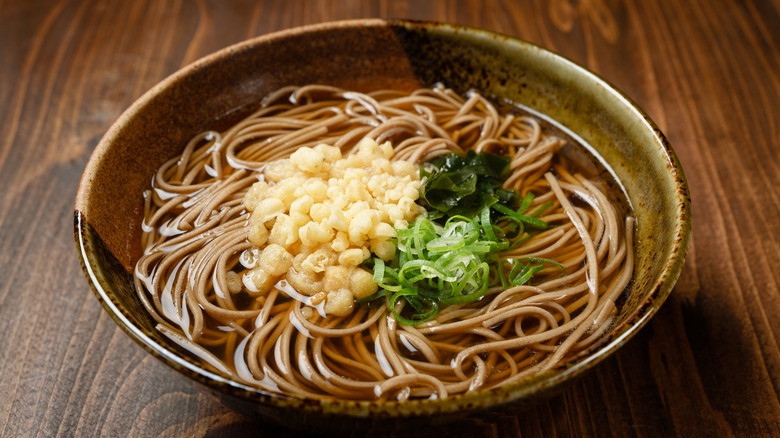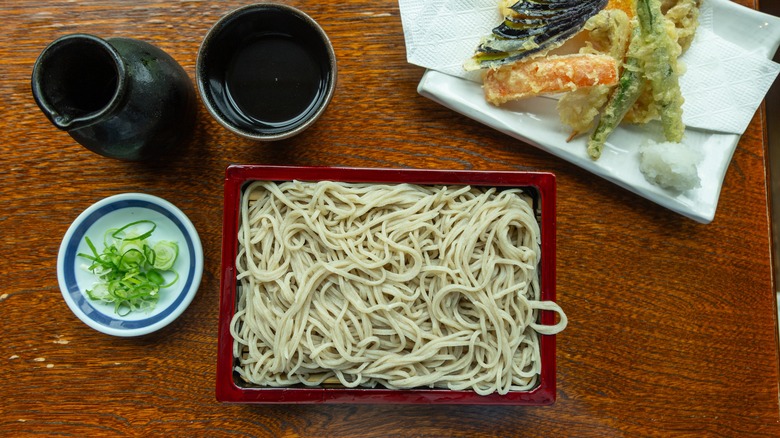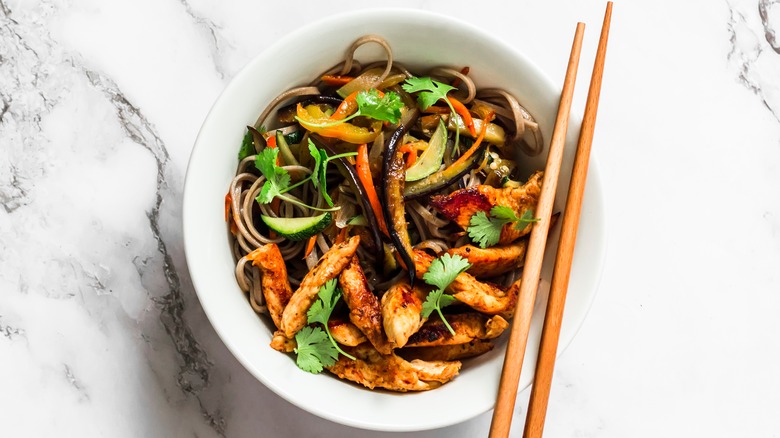There Are Only 2 Ways To Truly Enjoy Soba Noodles
The soba noodle craze is real. It's difficult not to love this Japanese cuisine made out of buckwheat. Their nutty and earthy taste has us adding them to salads and eating soba noodles with vegetables. But if you want to eat them like a pro, Namiko Hirasawa Chen (otherwise known as Nami), the creator behind the Japanese recipe blog Just One Cookbook, exclusively told Daily Meal there are only two ways to enjoy these noodles. Chen explained, "In Japan, soba noodles are served just two ways: In a hot soup broth or with a cold dipping sauce."
Soba noodles have a nutty taste to them and a chewy consistency. They are also a little grainy and crave simplicity. When served in hot broth, they absorb its flavor and become quite tasty. Try some soba noodles in mushroom broth with taro and kabocha squash for an authentic experience. The recipe blogger further shared that the type of broth used is very specific. She said, "Both types of broth are dashi-based with a soy sauce flavor." These liquids are umami-rich, imparting salty notes as well as sweet. It is often topped with a Japanese-style scrambled egg called tamago toji, or deep-fried flour batter called tenkasu, which is essentially bits of leftover fried tempura.
Rinse soba noodles in ice water
Broth isn't the only thing soba noodles bathe in. Namiko Hirasawa Chen said, "In Nagano, where soba comes from, cold soba often is enjoyed with chilled walnut dipping sauce." To make this light but delicious dish, you want to rinse the noodles in ice water, or at the very least cold water, and drain. It is important that they are properly chilled and free from starch to stop them clumping when you serve them. Fresh soba noodles will cook quicker than a dried version, so be watchful, otherwise they can become a little gummy when overcooked.
When it comes to the walnuts, they are ground until they are powder-like. The dipping salt is savory, and the noodles are quick to absorb it, so dipping them quickly will ensure the taste of each bite isn't too salty. And when it comes to how to eat soba noodles, make certain to slurp them up swiftly, or they might start sticking together. Still, while these are two traditional ways to eat soba noodles, that doesn't mean you have to be confined to either of them. Chen noted, "Now, soba is enjoyed worldwide and used in different ways. I see more various and interesting flavors around the world that are not familiar in Japan."
Make DIY soba noodle bowls
A chilled soba noodle salad dressed in a ponzu sauce will add a touch of citrus to this dish, and if you want to pile on some stir-fried veggies or a protein, you will have a very satiating meal. Ponzu is made using mirin — a sweet, almost sake-like liquid made from steamed mochi rice – soy sauce, rice vinegar, katsuobushi, kombu, and a mixture of lemon juice and lime juice. It is savory, sweet, citrusy, and delicious with soba noodles. If you prefer something on the spicy side, try tossing them in a spicy peanut sauce.
Additionally, soba noodles are so versatile that you can create a build-your-own soba noodle bowl dinner night and let your family or guests create their own take on this dish. Fill bowls with soba noodles and let the customization begin. Chop up your favorite veggies and roast them, toast some sesame seeds, have some of your favorite fresh herbs on hand, like cilantro or lemongrass, and some type of spicy element like minced Thai chiles. Make a sweet soy and honey sauce to dress them in.


